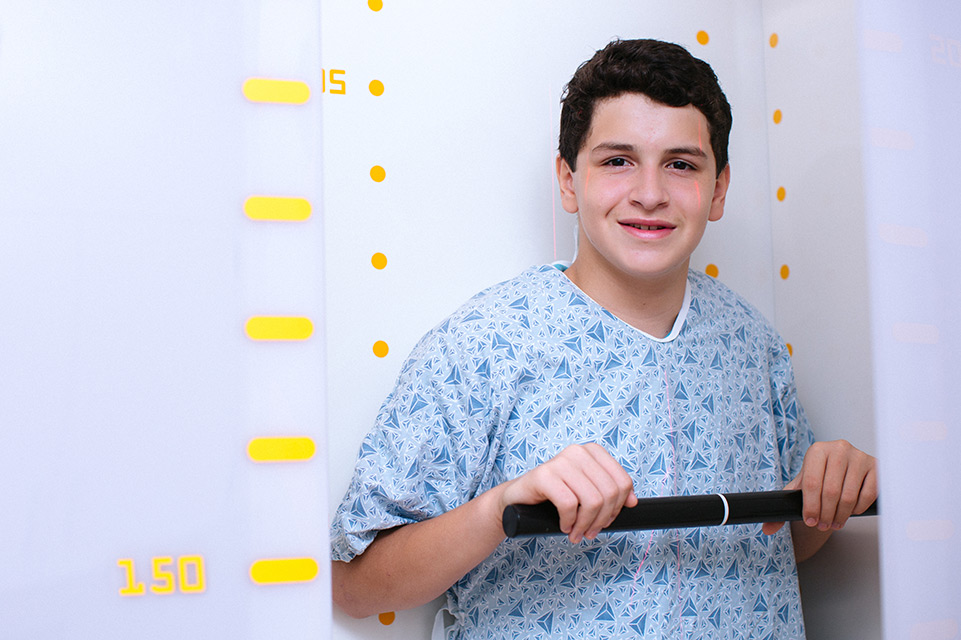Spondylosis Care
Shriners Children's can help that pain in the neck!
Shriners Children's physicians have vast experience treating a condition that is seen more frequently in older populations: spondylosis. This neck issue is a form of arthritis – an umbrella term for more than 100 conditions that cause painful joints.
The condition can be caused by poor posture, obesity and lack of exercise.
How Does Spondylosis Develop?
Normally, soft disks between the bones in the spine, called vertebrae, provide cushioning. When your child has spondylosis, these disks become squeezed, or compressed. As a result, your child's neck becomes more stiff.
When this happens, the connective tissue, called cartilage, that lines the vertebrae on each side of the disc can wear away. Once this protective cartilage is gone, bone spurs may develop on your child's vertebrae where they rub together. Nerves attached to your spinal cord may have less room to pass between the vertebrae on their way out of the spine.
Sometimes these changes can cause the spinal cord or nerve roots attached to it to become compressed. This can cause some symptoms in your child, including weak or clumsy legs or hands. However, many children don't have any symptoms.
Shriners Children's Approach to Care for Spondylosis
Your Shriners Children's physician will give your child a thorough exam. You will discuss any neck injuries your child has had and describe their symptoms. Other tests may help make a diagnosis. Our team approach to treatment may include things such as medication, physical therapy and, in rare cases, surgery.
Specific treatments and services may vary by location. Please contact a specific location for more information.
Spondylosis vs. Spondylolysis vs. Spondylolisthesis
Three Similar Words – Three Different Conditions
Spondylosis is different from spondylolysis and spondylolisthesis. Spondylosis occurs when cartilage, disks, ligaments and bones in your child's neck wear down. Poor posture, obesity and lack of exercise can enhance the problem.
Spondyolysis is a stress fracture in the lower back. Repetitive stress from sports can put kids at risk. Both spondyolysis and spondylolisthesis may cause low back pain.
Spondylolisthesis happens when a vertebra, weakened from a stress fracture, moves forward, slipping out of alignment from the rest of the spine.
Prevention
You may not be able to prevent cervical spondylosis in your child, but these steps may reduce their risk:
- Encourage them to be physically active
- Help them use good posture
- Teach them how to prevent neck injuries by always using the right equipment and the right form when exercising or playing sports
What Are the Symptoms?
Many children with spondylosis don't have symptoms. If they do, they might include:
- Pain in the neck that may travel to their arms or shoulders
- Headaches
- A grinding feeling when they move their neck
- Weakness in their arms and legs
- Numbness in their shoulders, arms or hands
- Stiffness in their neck
- Trouble keeping their balance, especially when walking
- Trouble controlling their bladder or bowels
Your First Appointment: What to Expect
Our focus will be on considering and discussing all the options for your child. Your Shriners Children's physician will perform a thorough history and physical examination, order X-rays and go over the details of your child's condition.
Then, you and your physician will develop a personalized treatment program for your child. This plan may include:
- Medicines: Nonsteroidal anti-inflammatory medicines, such as ibuprofen or aspirin, pain relievers and muscle relaxants may help.
- Physical therapy: Our in-house, board-certified physical therapist can teach you stretching and strengthening exercises that you can help your child with to ease their symptoms.
- Bracing: Wearing a soft collar around the neck for short periods may help your child's symptoms. Use caution however. If the collar is worn too long, it can cause the neck to weaken.
- Surgery: In most cases, surgery is not needed. If it is, our skilled surgeons can perform various procedures to relieve pressure on the spinal cord or the nerves leaving your child's spine. Your child's surgeon may also fuse bones in the spine.
I know I wouldn’t have the life I have with my husband and son without Shriners Children’s.

Physical Therapy Made Convenient
Services We Provide
View All Related Services
Athletic Training

Care Management


